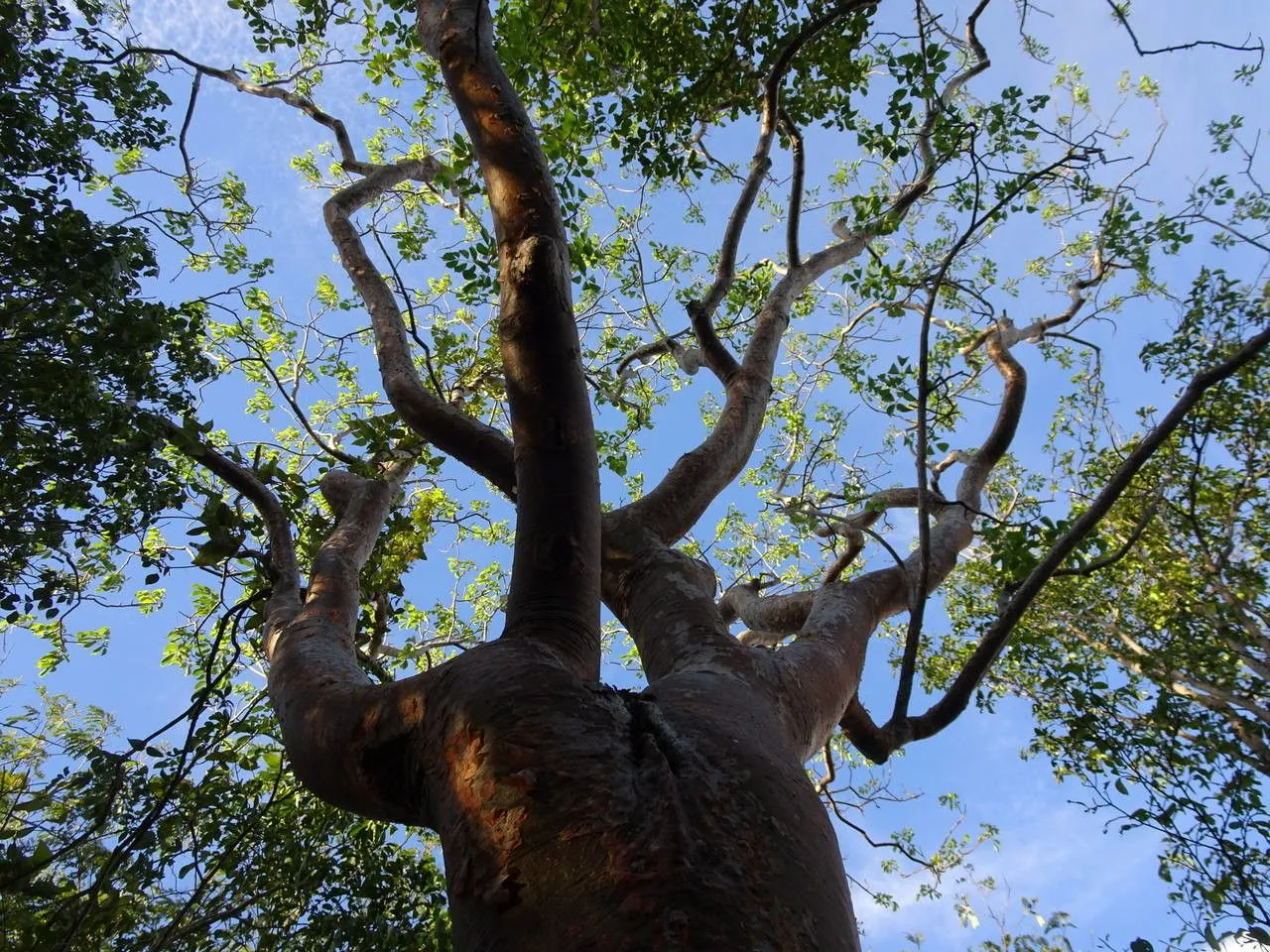
Author: (L.) Sarg.
Bibliography: Gard. & Forest 3: 260 (1890)
Year: 1890
Status: accepted
Rank: species
Genus: Bursera
Vegetable: False
Observations: Mexico to Brazil, Caribbean
West Indian-birch, scientifically known as Bursera simaruba, is a notable species within the Burseraceae family. This plant draws considerable interest due to its widespread distribution, spanning from Mexico to Brazil and encompassing a large portion of the Caribbean.
One of the most distinctive features of Bursera simaruba is its smooth, red bark that often peels away in thin sheets, giving it a unique and striking appearance. This characteristic bark not only adds to the visual appeal of the tree but also serves a practical purpose, helping the plant to shed any parasitic plants and pests that may try to take hold. This adaptability contributes to its extensive range across diverse climates and geographical regions.
West Indian-birch is known for its resilience and ability to thrive in various environmental conditions. This includes areas that experience seasonally dry climates, where the plant’s ability to conserve water and efficiently manage resources is crucial for its survival. The tree’s foliage is typically composed of pinnate leaves, which are arranged alternately on the branches, providing a lush canopy that offers shade and habitat for numerous species.
In addition to its ecological importance, Bursera simaruba holds cultural and medicinal significance in many of the regions it inhabits. Various parts of the plant, including its bark and leaves, have been traditionally used in folk medicine practices. It is valued for its potential anti-inflammatory and analgesic properties, making it a valuable resource for traditional healers.
The tree’s adaptability and usefulness also extend to its role in reforestation and land rehabilitation projects. Given its robust nature and its ability to tolerate poor soils and dry conditions, West Indian-birch is often a preferred species for restoring degraded landscapes and providing soil stabilization, thereby combating erosion and promoting biodiversity recovery.
Overall, Bursera simaruba serves as an exemplary species within the Burseraceae family, praised not only for its distinctive appearance and broad geographical distribution but also for its ecological, cultural, and practical contributions to the environments and communities it touches. Whether gracing the forests of Mexico, lining the coasts of the Caribbean, or standing resilient in the landscapes of Brazil, West Indian-birch continues to be a plant of remarkable interest and value.
This comprehensive compilation of information was gathered from the publication in Gard. & Forest 3: 260 (1890) by (L.) Sarg.
Spa: cascara sagrada | indioencuero | resbala monos, gumbo limbo, palo jiote, chaca, chakaj, jiote, mulato, palo mulato, thi- un, tzaca
Eng: west indian birch, west indian-birch, gumbo limbo, balsam tree, gum tree, gum-elemi, gumbo-limbo, lime tree, terpentine tree, tourist tree, turpentine tree, white man tree
Swe: amerikanskt balsamträd
Fra: bois de gommier blanc
En: West Indian-birch, Gumbo limbo, Birch-gum tree, Cha-ka, Chacah, Gumbo-limbo, Tourist tree, Turpentine tree, West Indian birch, Balsam Tree, Gum Tree, Gum-elemi, Lime Tree, Terpentine Tree, White Man Tree
Ar: بورسيرا سيماروبا
Zh: 銅木
Cs: Březule balzámová
Fi: Tärpättitohtorinpuu
Fr: Bois de gommier blanc, Gommier barrière, Gommier blanc
Ht: Gomye blan
Ml: ബർസെറ സിമാരുബ
Es: Palo jiote, Palo mulato, Gumbo limbo, Indio desnudo, Caraña, Jiñote, Jiñocuave., Almácigo blanco, Cascara sagrada | Indioencuero | Resbala monos, Chaca, Chakaj, Jiote, Mulato, Thi- un, Tzaca, Aceituno, Almácigo, Indio Pelado, Jiñocuabe, Papelillo
Sv: Amerikanskt balsamträd
© copyright of the Board of Trustees of the Royal Botanic Gardens, Kew.
© copyright of the Board of Trustees of the Royal Botanic Gardens, Kew.
© copyright of the Board of Trustees of the Royal Botanic Gardens, Kew.
Taken Apr 24, 2022 by Nelson Zamora Villalobos (cc-by-nc)
Taken Apr 24, 2022 by Nelson Zamora Villalobos (cc-by-nc)
Taken Jun 20, 2022 by Trap Hers (cc-by-sa)
Taken Feb 7, 2014 by Thomas Delhotal (cc-by-sa)
Taken Apr 11, 2016 by Thomas Delhotal (cc-by-sa)
Taken Jan 9, 2002 by Tela Botanica − Liliane ROUBAUDI (cc-by-sa)
Taken Dec 8, 2007 by Tela Botanica − Liliane Roubaudi (cc-by-sa)
Taken Apr 10, 2022 by eric rozzonelli (cc-by-sa)
Taken Jul 23, 2021 by Julio Moguel Yanes (cc-by-sa)
Taken Mar 9, 2019 by felipe (cc-by-sa)
Taken Feb 23, 2017 by Tela Botanica − Liliane ROUBAUDI (cc-by-sa)
Taken Feb 23, 2017 by Tela Botanica − Liliane ROUBAUDI (cc-by-sa)
Taken Apr 24, 2022 by Nelson Zamora Villalobos (cc-by-nc)
Taken May 19, 2022 by Len Stafford (cc-by-sa)
Taken Jul 23, 2021 by Julio Moguel Yanes (cc-by-sa)
Taken Apr 17, 2019 by OTS – J. González (cc-by-nc-sa)
Taken Oct 1, 2009 by OTS – Oviedo-Brenes, Federico (cc-by-nc-sa)
Taken Apr 24, 2022 by Nelson Zamora Villalobos (cc-by-nc)
Taken Feb 7, 2014 by Thomas Delhotal (cc-by-sa)
Taken Feb 7, 2014 by Thomas Delhotal (cc-by-sa)
Taken Apr 11, 2016 by Thomas Delhotal (cc-by-sa)
Taken May 28, 2016 by Thomas Delhotal (cc-by-sa)
Taken May 28, 2016 by Thomas Delhotal (cc-by-sa)
Taken May 28, 2016 by Thomas Delhotal (cc-by-sa)
Taken Jan 1, 1900 by EOL − Acevedo, P. (cc-by-nc-sa)
Taken Feb 19, 2017 by Nelson Zamora Villalobos (cc-by-nc)
Taken Jan 1, 1900 by EOL − Howard, R.A. (cc-by-nc-sa)
Taken Jan 1, 1900 by EOL − Howard, R.A. (cc-by-nc-sa)
Taken Aug 25, 2021 by Estanislau Francisco (cc-by-sa)
Growth habit: Tree, Shrub
Growth rate: Rapid
Ph maximum: 7.0
Ph minimum: 6.0
Family: Myrtaceae Author: (F.Muell.) K.D.Hill & L.A.S.Johnson Bibliography: Telopea 6: 402 (1995) Year: 1995 Status:…
Family: Rubiaceae Author: Pierre ex A.Froehner Bibliography: Notizbl. Bot. Gart. Berlin-Dahlem 1: 237 (1897) Year:…
Family: Sapindaceae Author: Koidz. Bibliography: J. Coll. Sci. Imp. Univ. Tokyo 32(1): 38 (1911) Year:…
Family: Asteraceae Author: A.Gray Bibliography: Pacif. Railr. Rep.: 107 (1857) Year: 1857 Status: accepted Rank:…
Family: Fabaceae Author: Medik. Bibliography: Vorles. Churpfälz. Phys.-Ökon. Ges. 2: 398 (1787) Year: 1787 Status:…
Family: Aspleniaceae Author: (Cav.) Alston Bibliography: Bull. Misc. Inform. Kew 1932: 309 (1932) Year: 1932…